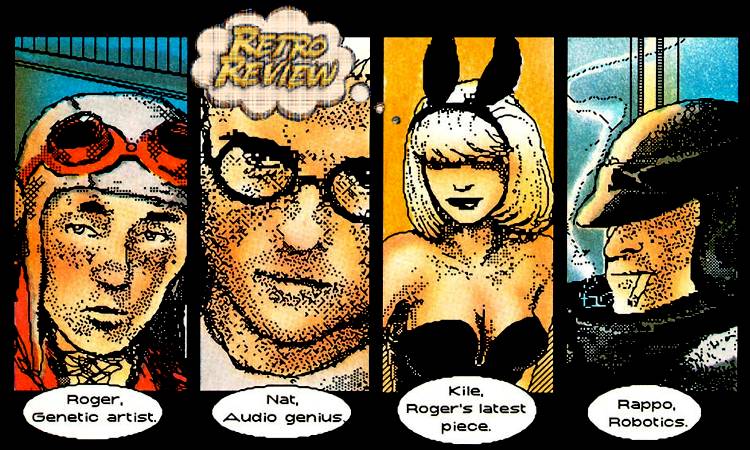With all the hubbub about “A.I.”, it’s important to remember that a computer is a tool, and it takes an artist to make comics, just as it did back in ’85. Your Major Spoilers Retro Review of Shatter #1 awaits!
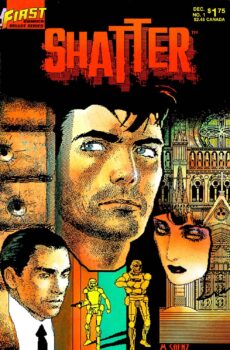 SHATTER #1
SHATTER #1
Writer: Mike Saenz, Mark Pierce
Penciler: Mike Saenz, Mark Pierce
Inker: Mike Saenz, Mark Pierce
Colorist: Mike Saenz, Mark Pierce
Letterer: Mike Saenz, Mark Pierce
Editor: Mike Gold
Publisher: First Comics
Cover Price: $1.75
Current Near-Mint Pricing: $2.00
Release Date: August 16, 1985
Previously in Shatter: Founded in 1983 (as with many a fledgling publisher raised by the tides of Teenage Mutant Ninja Turtles), First Comics’ most lasting works are probably the unusual trinity of Nexus, Badger, and Dreadstar, all of which predated First as an entity. But their publishing slate included Chaykin’s iconic American Flagg!, the adventures of Jon Sable as imagined by comics legend Mike Grell, and John Ostrander’s sublimely dark Grimjack. There were a lot of futuristic science-fiction-y books at First Comics, which leads us to today’s subject: The world of Sadr al-din Morales, known professionally as Shatter!
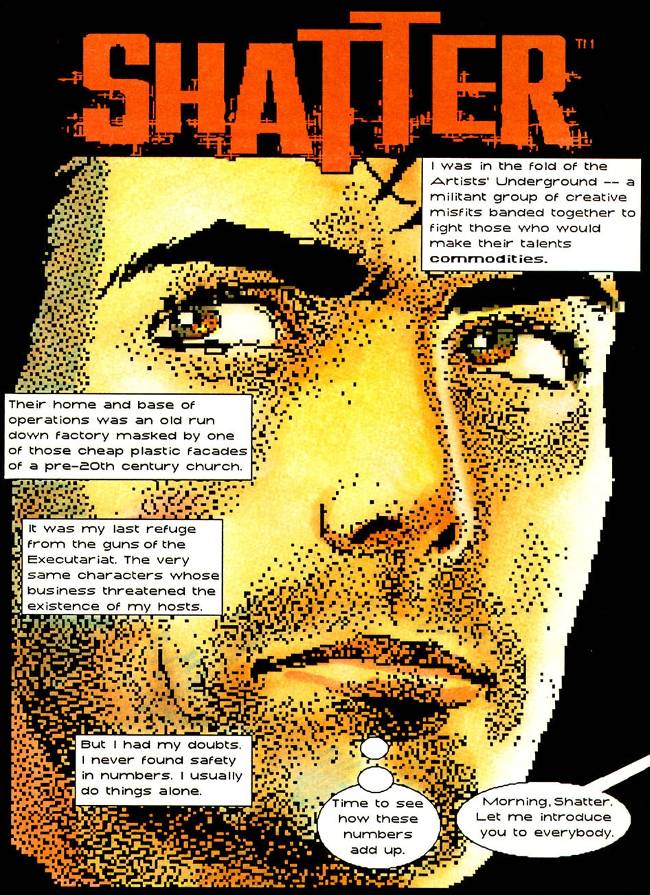 As is so often the case with these ’80s independent comics, the first issue of Shatter isn’t the first appearance, as the feature first appeared in a short-lived computer magazine called Big K. Shatter then spent a few issues as a backup feature in the pages of Jon Sable, Freelance, before this issue debuted. In the far-future year 20XX (definitely after the 2040s, but not specified, as far as I can tell), Sadr is a police officer. Well, in the strictest sense, he’s a temporary police officer, as all jobs are temp gigs, and his is subcontracted under the name Jack Scratch. After falling in with a woman named Cyan, Scratch/Sadr/Shatter is hiding out with her friends, a group of bohemians known as the Artist’s Underground, all of whom have reason to avoid the scrutiny of the police. The future corporate overlords of Simon Shuster Jovanovich have moved on from printing books to printing the RNA of individuals, allowing users to channel whatever abilities those people have at the price of having their brains extracted and distilled down.
As is so often the case with these ’80s independent comics, the first issue of Shatter isn’t the first appearance, as the feature first appeared in a short-lived computer magazine called Big K. Shatter then spent a few issues as a backup feature in the pages of Jon Sable, Freelance, before this issue debuted. In the far-future year 20XX (definitely after the 2040s, but not specified, as far as I can tell), Sadr is a police officer. Well, in the strictest sense, he’s a temporary police officer, as all jobs are temp gigs, and his is subcontracted under the name Jack Scratch. After falling in with a woman named Cyan, Scratch/Sadr/Shatter is hiding out with her friends, a group of bohemians known as the Artist’s Underground, all of whom have reason to avoid the scrutiny of the police. The future corporate overlords of Simon Shuster Jovanovich have moved on from printing books to printing the RNA of individuals, allowing users to channel whatever abilities those people have at the price of having their brains extracted and distilled down.
And now, Shatter is going to help Cyan get back the essence of dead friends.
 The earliest chapter of Shatter, including this issue, was drawn by Mark Saenz using a first-gen MacIntosh computer, which is an achievement in itself, given that it had a TINY monochrome screen and that the drawing was done with the mouse, as there wasn’t a graphic pen peripheral yet available. That makes the existence of this comic remarkable enough, but as the shot of the Collective’s hopper over future Chicago(?) is just plain pretty. Saenz’s art even makes it clear that it’s Shatter behind the mask as they make their way into various RNA banks, using his police access to “confiscate” as much RNA as they can. During that process, it is revealed that, unlike most users, Shatter has no bad side effects from shooting RNA, which may make him the key to unlocking a less complicated RNA transfer procedure in the future.
The earliest chapter of Shatter, including this issue, was drawn by Mark Saenz using a first-gen MacIntosh computer, which is an achievement in itself, given that it had a TINY monochrome screen and that the drawing was done with the mouse, as there wasn’t a graphic pen peripheral yet available. That makes the existence of this comic remarkable enough, but as the shot of the Collective’s hopper over future Chicago(?) is just plain pretty. Saenz’s art even makes it clear that it’s Shatter behind the mask as they make their way into various RNA banks, using his police access to “confiscate” as much RNA as they can. During that process, it is revealed that, unlike most users, Shatter has no bad side effects from shooting RNA, which may make him the key to unlocking a less complicated RNA transfer procedure in the future.
And remember how I said the Mac made for some pretty pictures?
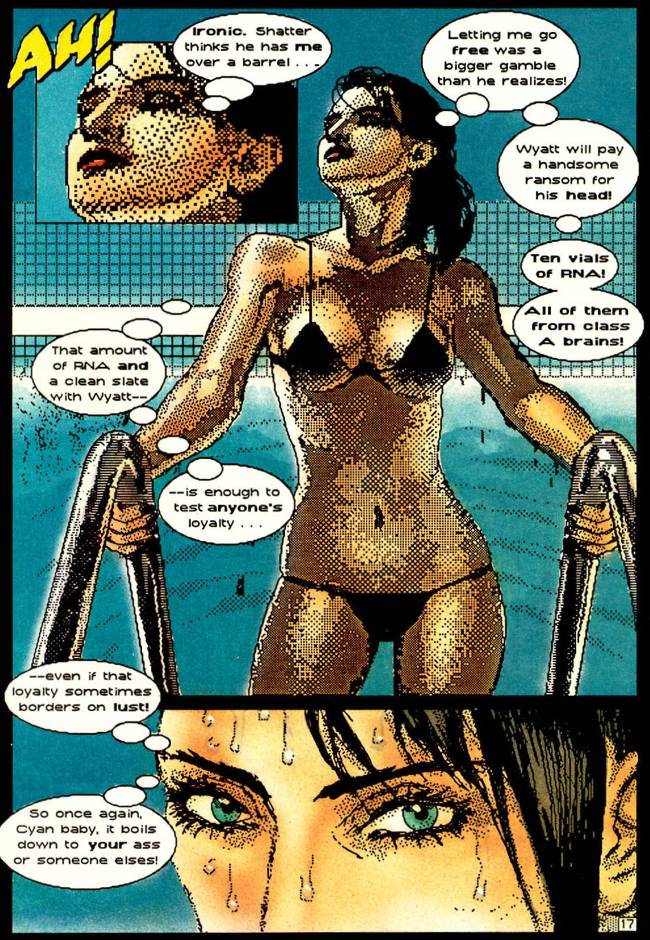 Cyan enjoys swimming to clear her mind, and once again, it’s kind of amazing what Saenz can do with 128k of RAM and a little hand-coloring of the printed art. Cyan’s worries are valid as she is still the subject of an open contract for any temp cops who cross her path, including Shatter himself. Worse still, she’s playing both sides, contacting the CEO of the very company they’ve been robbing from to feel out what he’d pay to get back the precious genetic material… and alerting his stormtroopers to their location!
Cyan enjoys swimming to clear her mind, and once again, it’s kind of amazing what Saenz can do with 128k of RAM and a little hand-coloring of the printed art. Cyan’s worries are valid as she is still the subject of an open contract for any temp cops who cross her path, including Shatter himself. Worse still, she’s playing both sides, contacting the CEO of the very company they’ve been robbing from to feel out what he’d pay to get back the precious genetic material… and alerting his stormtroopers to their location!
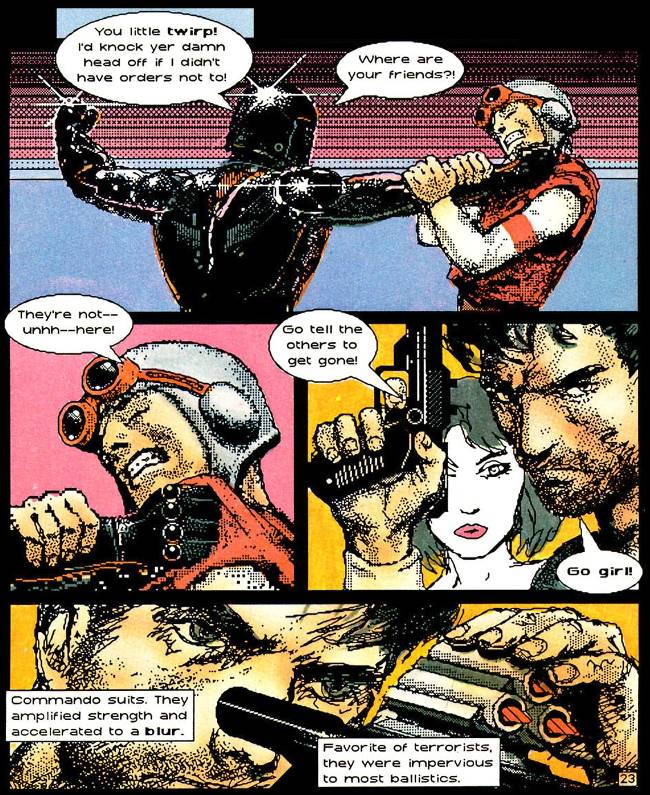 First books were printed without the oversight of the Comics Code Authority, which allows the levels of sex and violence to go past what the big publishers were up to, making Shatter’s confrontation with the armored guards to be a bloody affair, full of severed limbs and exploding heads, all digitally rendered. In all honesty, as revolutionary as the technique was, the finished product just feels like a specific artistic style, no stranger than the work of Humberto Ramos or Mike Allred today. As for Shatter, even a Man With a Golden Brain can be outnumbered, but he awakens to find himself face-to-face with Wyatt Courtney, the big boss of SS&J.
First books were printed without the oversight of the Comics Code Authority, which allows the levels of sex and violence to go past what the big publishers were up to, making Shatter’s confrontation with the armored guards to be a bloody affair, full of severed limbs and exploding heads, all digitally rendered. In all honesty, as revolutionary as the technique was, the finished product just feels like a specific artistic style, no stranger than the work of Humberto Ramos or Mike Allred today. As for Shatter, even a Man With a Golden Brain can be outnumbered, but he awakens to find himself face-to-face with Wyatt Courtney, the big boss of SS&J.
And he has an offer for the erstwhile Jack Scratch.
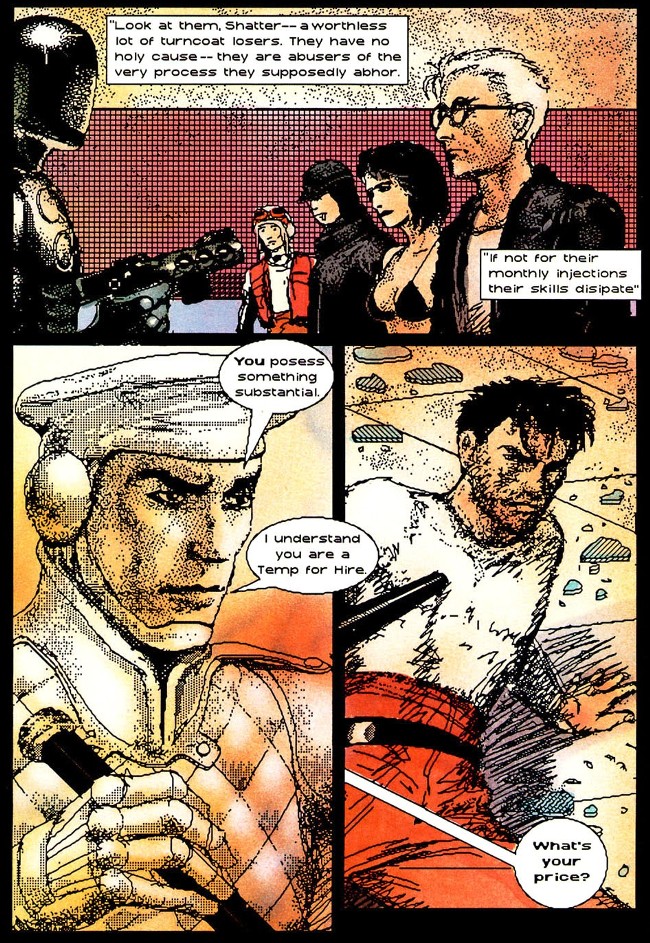 When it comes to science-fiction stories, visions of the future are commonplace, but this world feels oddly accurate, predicting the proliferation of temporary jobs, the endless corporate mergers that build larger and larger conglomerates, and the devaluation of human talents as commodities to be bought and sold. The fact that it was drawn using digital techniques is likewise decades ahead of the curve, making Shatter #1 one of those comic books that I own solely to pore over and absorb as a historical document, but providing art that fascinates and an early cyberpunk vision for 4.5 out of 5 stars overall. It’s a book that anyone interested in the history of comic creation, techniques, and tools needs to be aware of (with the caveat that the vision of a creator is what makes it art).
When it comes to science-fiction stories, visions of the future are commonplace, but this world feels oddly accurate, predicting the proliferation of temporary jobs, the endless corporate mergers that build larger and larger conglomerates, and the devaluation of human talents as commodities to be bought and sold. The fact that it was drawn using digital techniques is likewise decades ahead of the curve, making Shatter #1 one of those comic books that I own solely to pore over and absorb as a historical document, but providing art that fascinates and an early cyberpunk vision for 4.5 out of 5 stars overall. It’s a book that anyone interested in the history of comic creation, techniques, and tools needs to be aware of (with the caveat that the vision of a creator is what makes it art).
Dear Spoilerite,
At Major Spoilers, we strive to create original content that you find interesting and entertaining. Producing, writing, recording, editing, and researching requires significant resources. We pay writers, podcast hosts, and other staff members who work tirelessly to provide you with insights into the comic book, gaming, and pop culture industries. Help us keep MajorSpoilers.com strong. Become a Patron (and our superhero) today.
SHATTER #1
Shatter's vision of the future gets a lot of things right, but the use of MacPaint to create the art is what makes it most historically relevant. Worth picking up, it'll be an absolute steal.
-
Writing9
-
Art10
-
Coloring8


